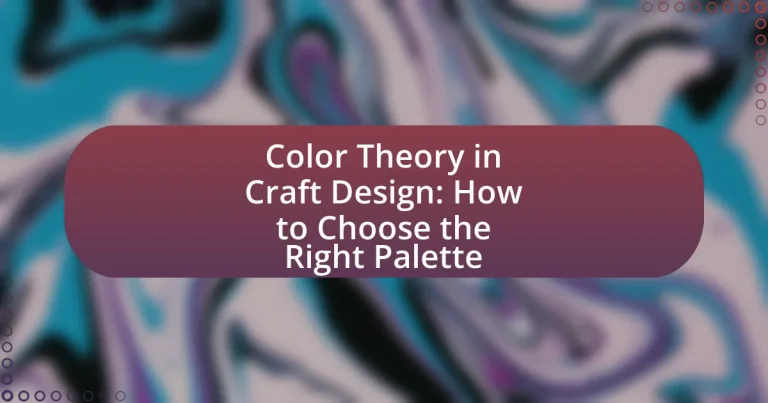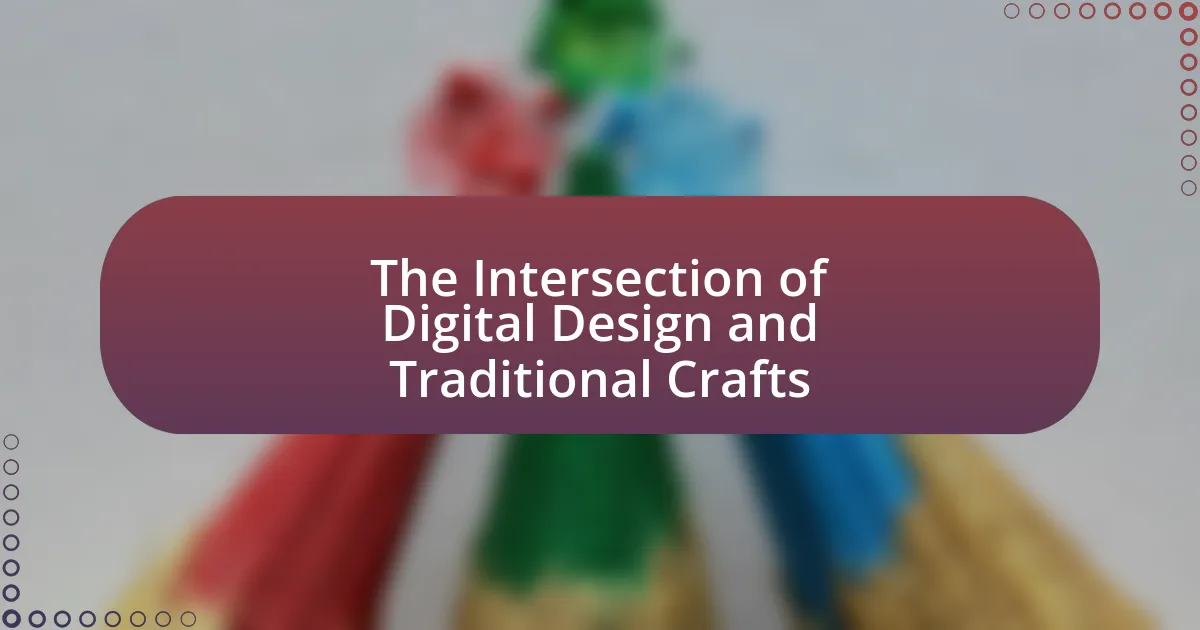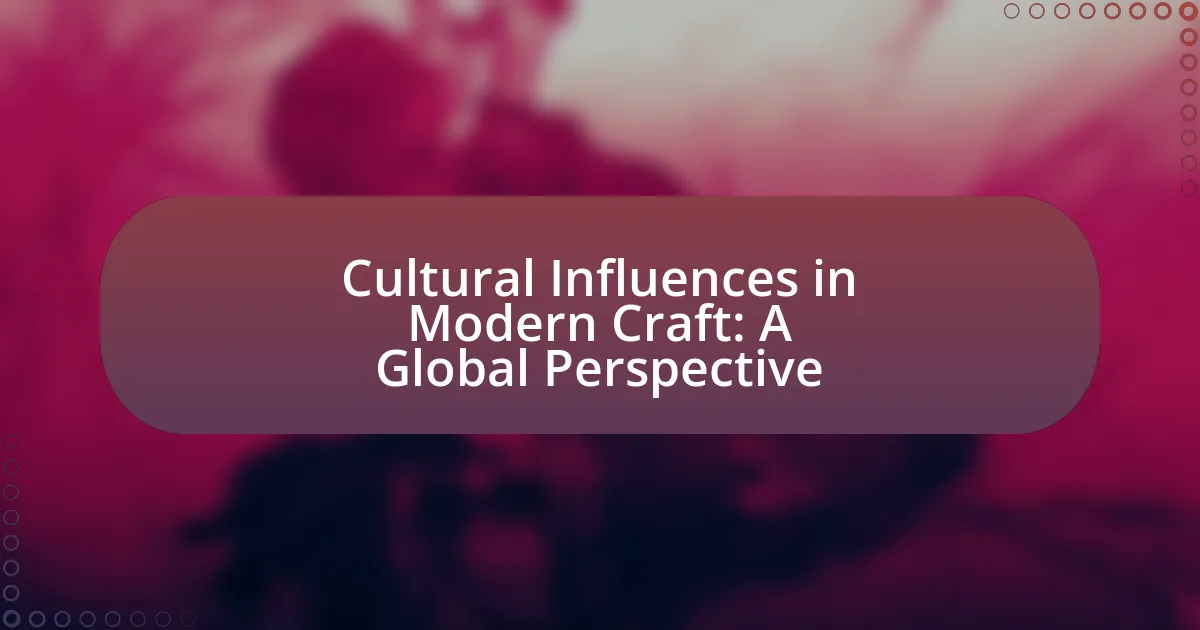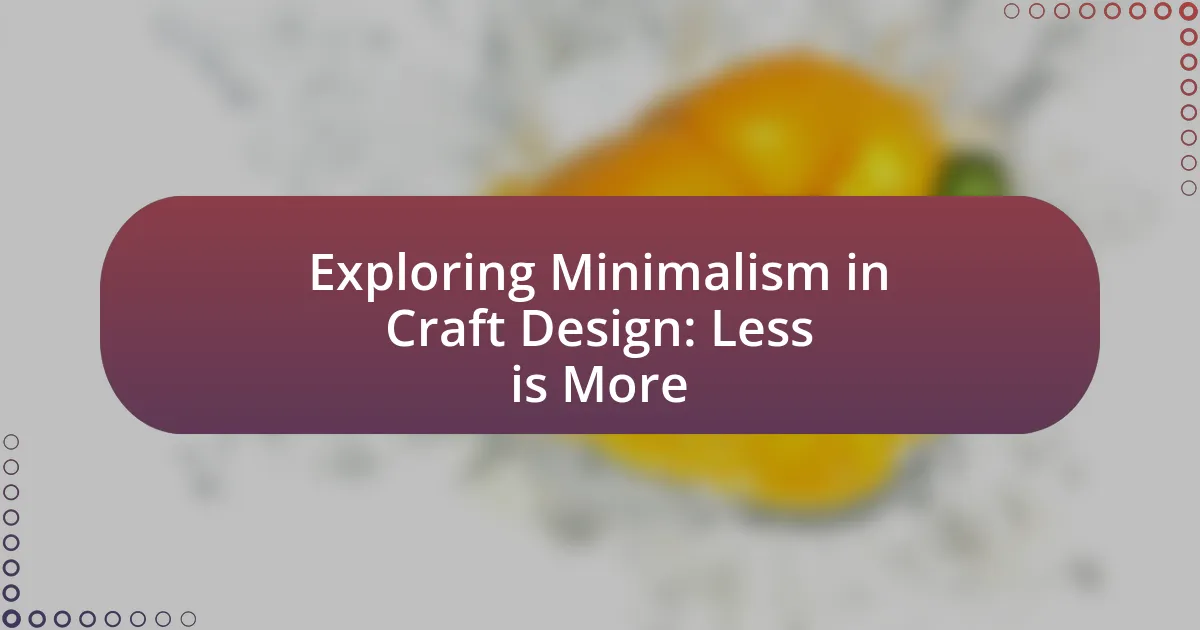Color theory in craft design encompasses the principles that guide the use of color in artistic contexts, focusing on color relationships, interactions, and emotional responses. The article outlines how understanding color theory influences design choices, emphasizing the importance of selecting appropriate color palettes to evoke specific emotions and enhance visual appeal. Key principles discussed include the color wheel, color harmony, and the psychological effects of color, along with practical tips for creating cohesive palettes and avoiding common mistakes. Additionally, the article explores different color models, such as RGB and CMYK, and their applications in digital and print design, providing resources for effective color palette generation.

What is Color Theory in Craft Design?
Color theory in craft design refers to the principles and guidelines that govern the use of color in artistic and design contexts. It encompasses the relationships between colors, how they interact, and the emotional responses they evoke. Understanding color theory allows designers to create harmonious palettes that enhance the visual appeal and effectiveness of their crafts. For instance, complementary colors, which are opposite each other on the color wheel, can create vibrant contrasts, while analogous colors, which are next to each other, can produce serene and cohesive designs. This foundational knowledge is essential for making informed choices about color combinations that resonate with the intended audience and purpose of the craft.
How does color theory influence craft design choices?
Color theory significantly influences craft design choices by guiding the selection of color palettes that evoke specific emotions and responses. Designers utilize principles such as the color wheel, complementary colors, and color harmony to create visually appealing and effective designs. For instance, research indicates that warm colors like red and yellow can stimulate energy and excitement, while cool colors like blue and green promote calmness and relaxation. This understanding allows designers to strategically choose colors that align with the intended message or purpose of their craft, enhancing the overall impact and effectiveness of their work.
What are the fundamental principles of color theory?
The fundamental principles of color theory include the color wheel, color harmony, and the psychological effects of color. The color wheel, developed by Isaac Newton, organizes colors into primary, secondary, and tertiary categories, providing a visual representation of color relationships. Color harmony refers to the aesthetically pleasing arrangement of colors, achieved through various schemes such as complementary, analogous, and triadic combinations. The psychological effects of color highlight how different colors can evoke specific emotions and responses, influencing design choices in craft and art. These principles are essential for creating effective and visually appealing palettes in craft design.
How do color relationships affect design outcomes?
Color relationships significantly influence design outcomes by affecting visual harmony, emotional response, and user engagement. For instance, complementary colors create contrast that can draw attention and enhance readability, while analogous colors promote a sense of unity and calmness. Research indicates that color combinations can evoke specific emotions; for example, blue and green hues are often associated with tranquility, while red and yellow can stimulate excitement. This understanding of color relationships is essential for designers aiming to create effective and appealing visual compositions.
Why is choosing the right color palette important in craft design?
Choosing the right color palette is crucial in craft design because it directly influences the emotional response and aesthetic appeal of the final product. A well-selected color palette can enhance the visual harmony and coherence of a design, making it more attractive to the audience. Research indicates that colors can evoke specific emotions; for instance, blue often conveys calmness, while red can evoke excitement. This psychological impact of color is supported by studies in color theory, such as those by Johannes Itten, who emphasized the importance of color relationships in creating effective designs. Therefore, selecting an appropriate color palette not only improves the overall design quality but also engages the viewer on a deeper emotional level.
What impact does color have on the perception of a craft?
Color significantly influences the perception of a craft by evoking emotional responses and shaping aesthetic judgments. Research indicates that colors can affect mood and feelings; for instance, warm colors like red and orange often convey energy and excitement, while cool colors like blue and green tend to evoke calmness and tranquility. A study published in the Journal of Experimental Psychology found that color can alter consumer perceptions of product quality and desirability, with specific hues enhancing the perceived value of crafted items. Thus, the choice of color in craft design not only impacts visual appeal but also affects how the audience emotionally connects with the work.
How can color choices enhance or detract from a design?
Color choices can significantly enhance or detract from a design by influencing perception, mood, and functionality. For instance, warm colors like red and orange can evoke excitement and energy, making them suitable for designs aimed at attracting attention, while cool colors like blue and green promote calmness and can create a sense of trust. Research indicates that color can affect consumer behavior; a study by the Institute for Color Research found that people make a subconscious judgment about a product within 90 seconds of initial viewing, with up to 90% of that assessment based on color alone. Therefore, selecting the appropriate color palette is crucial for achieving the desired emotional response and ensuring effective communication in design.
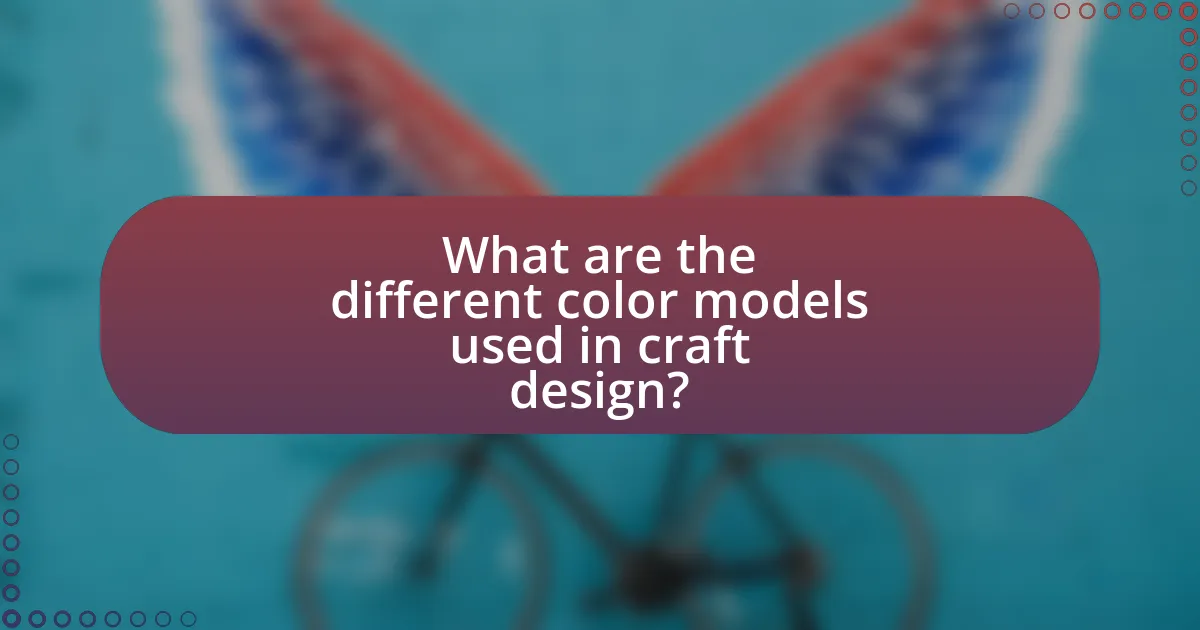
What are the different color models used in craft design?
The different color models used in craft design include RGB, CMYK, HSL, and LAB. RGB (Red, Green, Blue) is primarily used for digital designs, as it combines light colors to create various hues. CMYK (Cyan, Magenta, Yellow, Black) is utilized in print design, where colors are produced through ink mixing. HSL (Hue, Saturation, Lightness) offers a more intuitive way to understand color relationships, making it useful for selecting color palettes. LAB (Lightness, A, B) is a color model that aims to be perceptually uniform, allowing for consistent color representation across different devices. Each model serves specific purposes in craft design, ensuring accurate color reproduction and effective visual communication.
How do RGB and CMYK color models differ in application?
RGB and CMYK color models differ primarily in their application based on the medium of output. RGB (Red, Green, Blue) is an additive color model used for digital displays, where colors are created by combining light in varying intensities, making it ideal for screens and digital design. In contrast, CMYK (Cyan, Magenta, Yellow, Key/Black) is a subtractive color model used in color printing, where colors are produced by subtracting varying percentages of light absorbed by inks on paper, making it suitable for physical print materials. This distinction is crucial as RGB can produce a wider range of colors compared to CMYK, which is limited by the inks used in printing.
What are the advantages of using RGB in digital craft design?
The advantages of using RGB in digital craft design include a wide color gamut, ease of use in digital applications, and compatibility with various devices. RGB allows designers to create vibrant and diverse color combinations, as it combines red, green, and blue light in different intensities to produce a broad spectrum of colors. This model is particularly effective for screens, where colors are displayed through light emission, ensuring that designs appear as intended across different digital platforms. Additionally, RGB is the standard color model for web design and digital graphics, making it a practical choice for designers aiming for consistency and accuracy in their work.
When is CMYK preferred for print-based crafts?
CMYK is preferred for print-based crafts when the final product requires high-quality color reproduction, particularly for materials like brochures, posters, and packaging. This color model is specifically designed for color printing, as it uses four ink colors—cyan, magenta, yellow, and black—to create a wide range of colors through subtractive color mixing. The preference for CMYK arises from its ability to produce more accurate and vibrant colors on physical media compared to RGB, which is suited for digital displays. In professional printing, CMYK is the standard because it aligns with the color separation process used in commercial printing, ensuring consistency and fidelity in the final printed output.
What role do color harmonies play in selecting a palette?
Color harmonies are essential in selecting a palette as they create visual balance and aesthetic appeal. By utilizing color harmonies, designers can ensure that the colors chosen work well together, enhancing the overall composition. For instance, complementary color schemes, which involve colors opposite each other on the color wheel, create high contrast and vibrancy, making elements stand out. In contrast, analogous color schemes, which consist of colors next to each other on the wheel, provide a more serene and cohesive look. Research in color theory, such as the findings by Johannes Itten in “The Art of Color,” supports the idea that harmonious color combinations can evoke specific emotions and responses, thereby influencing the effectiveness of a design.
What are the main types of color harmonies?
The main types of color harmonies are complementary, analogous, triadic, split-complementary, and monochromatic. Complementary color harmony involves colors opposite each other on the color wheel, creating high contrast and vibrant visuals. Analogous harmony consists of colors next to each other on the wheel, providing a serene and comfortable design. Triadic harmony uses three evenly spaced colors on the wheel, offering a balanced yet colorful palette. Split-complementary harmony combines one base color with two adjacent to its complementary color, allowing for contrast without the intensity of direct complements. Monochromatic harmony utilizes variations in lightness and saturation of a single color, resulting in a cohesive and unified look. These classifications are foundational in color theory, guiding designers in creating visually appealing palettes.
How can complementary colors enhance visual appeal?
Complementary colors enhance visual appeal by creating high contrast and vibrant interactions that draw attention. When placed next to each other, these colors intensify each other’s brightness, making designs more striking and engaging. For example, the combination of blue and orange or red and green can evoke strong emotional responses and create a sense of balance in visual compositions. This principle is supported by color theory, which indicates that complementary colors are opposite each other on the color wheel, leading to a dynamic visual experience that can captivate viewers.
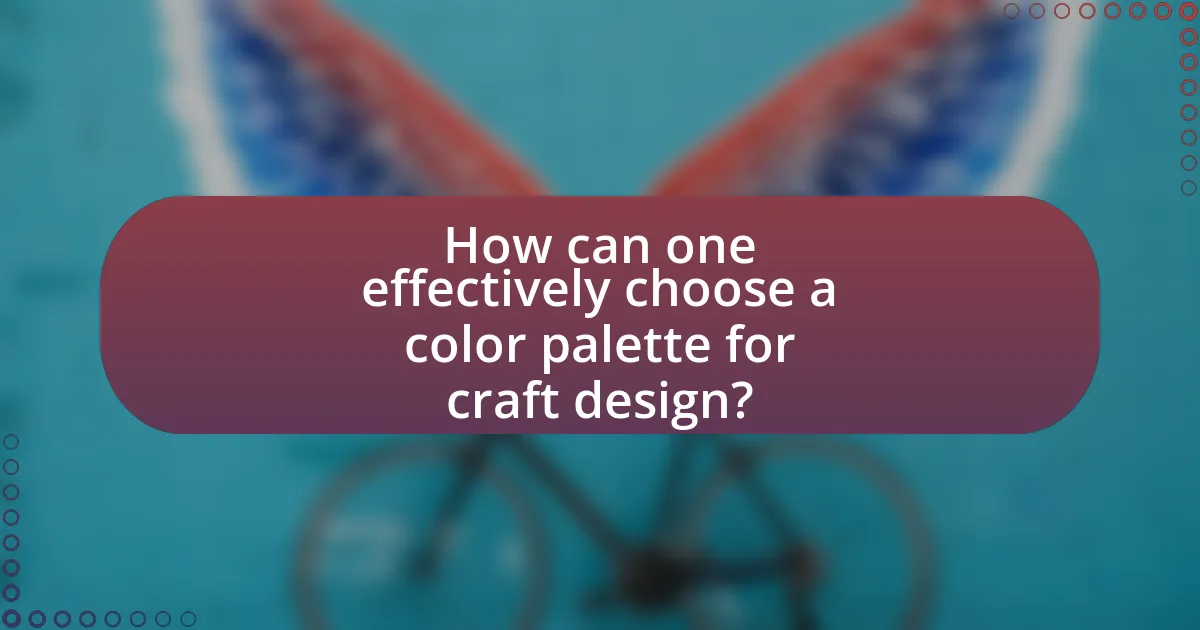
How can one effectively choose a color palette for craft design?
To effectively choose a color palette for craft design, one should start by understanding color theory principles, such as the color wheel, complementary colors, and color harmony. Utilizing these principles allows designers to create visually appealing combinations that evoke desired emotions and responses. For instance, complementary colors, which are opposite each other on the color wheel, create high contrast and vibrant designs, while analogous colors, which are next to each other, provide a more harmonious and serene look. Research indicates that color choices can significantly impact consumer perception and emotional response, highlighting the importance of selecting colors that align with the intended message or theme of the craft project.
What steps should be taken to create a cohesive color palette?
To create a cohesive color palette, start by selecting a base color that reflects the desired mood or theme. This base color serves as the foundation for the palette. Next, identify complementary colors that enhance the base color; these can be found using color theory tools like the color wheel, which illustrates relationships between colors. Incorporate analogous colors, which are adjacent to the base color on the color wheel, to create harmony. Additionally, consider the use of neutral colors to balance the palette and provide visual relief. Finally, test the palette in various contexts to ensure it maintains cohesion across different applications. This method is supported by color theory principles, which emphasize the importance of color relationships in design.
How can one use color wheel tools to select colors?
One can use color wheel tools to select colors by identifying complementary, analogous, or triadic color schemes that enhance visual harmony. Color wheel tools visually represent the relationships between colors, allowing users to easily find colors that work well together. For instance, complementary colors are located opposite each other on the wheel, creating high contrast and vibrant combinations, while analogous colors, found next to each other, provide a more harmonious and cohesive look. This method is widely utilized in design fields, as studies show that color combinations significantly impact aesthetic appeal and emotional response, reinforcing the importance of effective color selection in craft design.
What are the best practices for testing color combinations?
The best practices for testing color combinations include using color contrast tools, conducting user testing, and applying color harmony principles. Color contrast tools, such as the WebAIM Contrast Checker, help ensure accessibility by verifying that text is legible against background colors. User testing involves gathering feedback from a diverse group of individuals to assess emotional responses and preferences regarding color pairings. Additionally, applying color harmony principles, such as complementary, analogous, or triadic schemes, can guide effective combinations that are visually appealing. Research indicates that well-tested color combinations can enhance user experience and engagement, as seen in studies on color psychology and design effectiveness.
What common mistakes should be avoided when choosing colors?
Common mistakes to avoid when choosing colors include neglecting color harmony, failing to consider the context, and overlooking the psychological impact of colors. Color harmony is essential; using colors that clash can create visual discomfort. For instance, complementary colors can enhance contrast, while analogous colors provide a more cohesive look. Additionally, context matters; colors may appear differently under various lighting conditions, affecting their perception. Lastly, colors evoke emotions; for example, blue often conveys calmness, while red can signify urgency. Understanding these principles helps in making informed color choices that enhance design effectiveness.
How can over-saturation of colors affect a design?
Over-saturation of colors can negatively impact a design by overwhelming the viewer and creating visual chaos. When colors are overly saturated, they can clash and distract from the intended message or aesthetic, leading to a lack of harmony in the composition. Research indicates that high saturation can cause eye strain and fatigue, making it difficult for viewers to engage with the design effectively. For instance, a study published in the Journal of Vision found that overly saturated colors can impair readability and comprehension, particularly in text-heavy designs. Thus, maintaining a balanced color palette is essential for effective communication and visual appeal in design.
What are the pitfalls of ignoring color psychology?
Ignoring color psychology can lead to ineffective communication and negative emotional responses from the audience. When designers overlook the psychological impact of colors, they risk creating products that fail to resonate with consumers, potentially resulting in decreased sales and brand loyalty. For instance, research indicates that 85% of consumers make purchasing decisions based on color, highlighting the importance of aligning color choices with the intended message and emotional appeal. Additionally, inappropriate color use can create confusion or misinterpretation of a brand’s identity, ultimately harming its reputation and market position.
What practical tips can help in selecting the right color palette?
To select the right color palette, start by understanding the emotional impact of colors, as different hues evoke specific feelings; for example, blue often conveys calmness while red can signify energy. Next, consider the color wheel to identify complementary colors, which enhance each other when paired, creating visual harmony. Additionally, limit your palette to three to five colors to maintain cohesion and avoid overwhelming the viewer. Finally, test your palette in various lighting conditions, as colors can appear differently under natural and artificial light, ensuring the chosen colors work well in the intended environment.
How can one draw inspiration from nature and surroundings?
One can draw inspiration from nature and surroundings by observing the colors, patterns, and textures present in the environment. For instance, the vibrant hues of flowers, the subtle gradients of a sunset, and the intricate designs found in leaves can all inform color choices in craft design. Research indicates that natural settings can enhance creativity and promote innovative thinking, as demonstrated in a study published in the Journal of Environmental Psychology, which found that exposure to nature increases cognitive flexibility and problem-solving abilities. By integrating these elements into their work, designers can create palettes that resonate with the beauty and complexity of the natural world.
What resources are available for color palette generation?
Resources available for color palette generation include online tools, software applications, and design communities. Websites like Adobe Color, Coolors, and Color Hunt provide user-friendly interfaces for creating and exploring color schemes. Additionally, software such as Adobe Illustrator and Photoshop offers built-in color palette generators. Design communities on platforms like Dribbble and Behance allow users to share and discover color palettes used in various projects, enhancing inspiration and collaboration. These resources are widely recognized in the design industry for their effectiveness in aiding color selection and palette creation.
